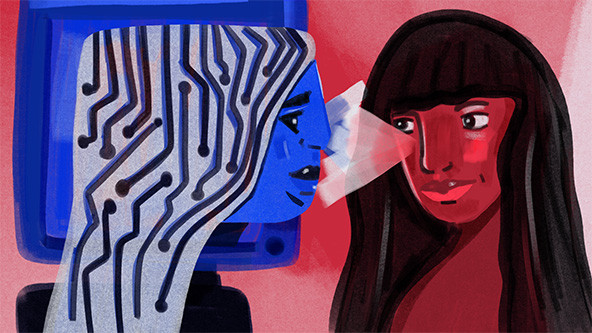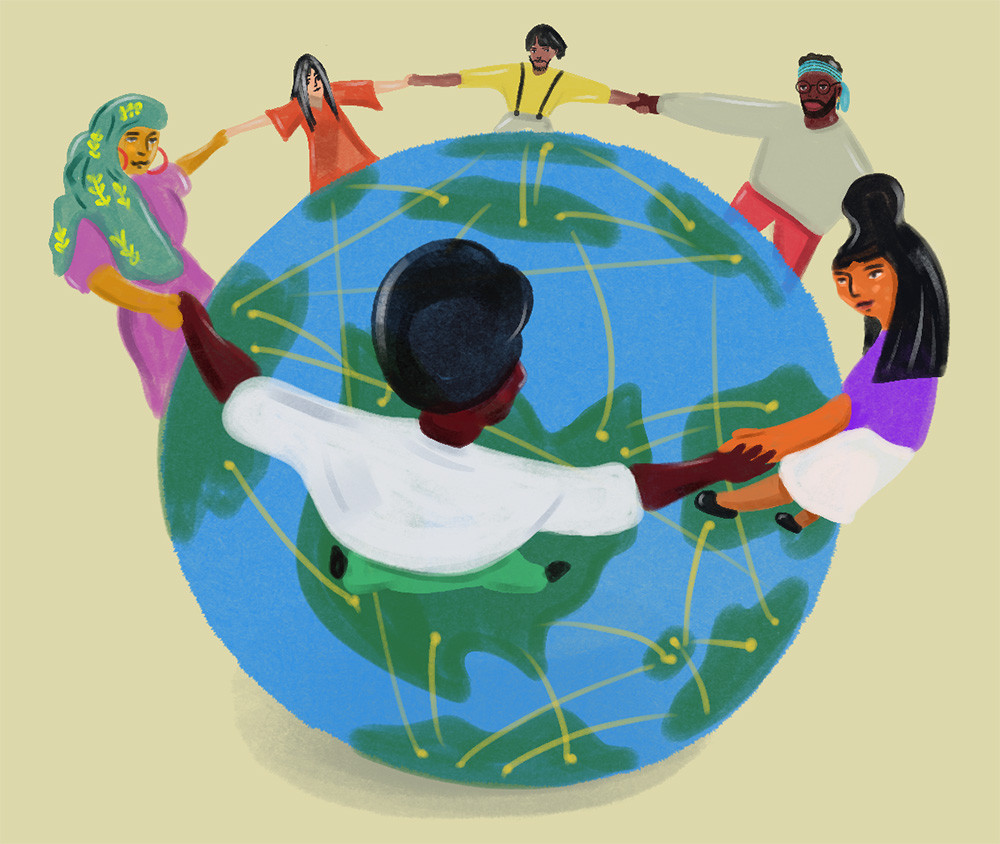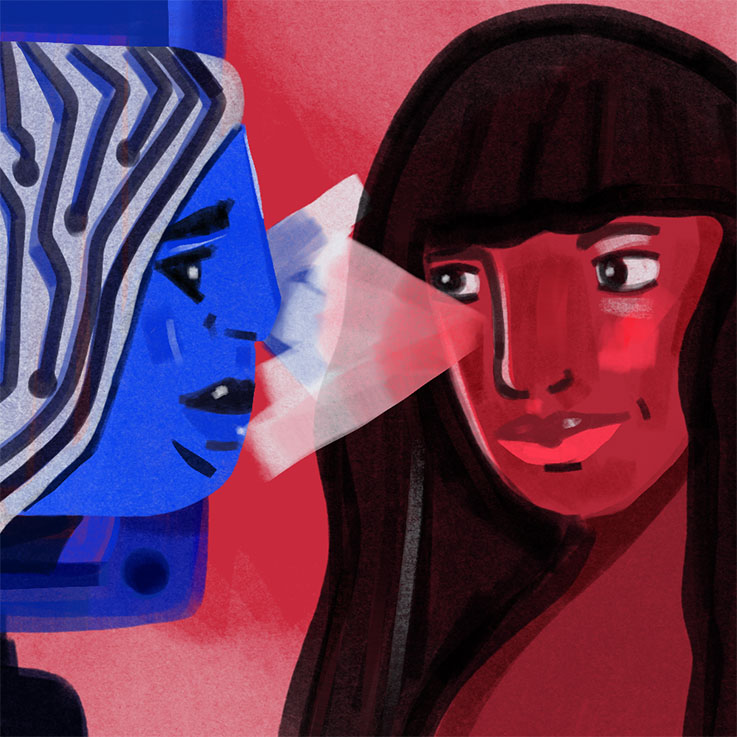
(Illustration by Raffi Marhaba, The Dream Artistic)
Synthetic intelligence is quickly evolving and reshaping how individuals and organizations suppose and behave, throughout many sectors and all over the world. In the USA, corporations like Netflix and Amazon have been leveraging AI for years to tailor suggestions and supply digital help to clients, whereas analysis establishments and AI labs like DeepMind are utilizing it to speed up medical analysis and combat local weather change.
Nonprofit organizations, nevertheless, have been much less concerned on this second of technological innovation. To some extent, this is smart. The nonprofit sector faces widespread challenges, together with an absence of funding in analysis and improvement and a scarcity of employees with AI experience, that different sectors don’t. However it additionally wants to alter. AI’s influence on society—how individuals work and dwell—will solely enhance over time, and the social sector can’t afford to not interact with it. Certainly, nonprofits have an vital position to play in its improvement. When designed and applied with fairness in thoughts, AI instruments may also help shut the info hole, cut back bias, and make nonprofits simpler. Funders, nonprofit leaders, and AI specialists want to maneuver shortly and in alignment with each other to advance equitable AI within the social sector.

The World Pursuit of Fairness
Utilizing AI to Help Fairness
After all, whereas AI affords many thrilling alternatives, its potential to trigger critical hurt is well-known. Builders prepare AI algorithms utilizing knowledge culled from throughout society, which suggests biases are baked in from the beginning. For instance, monetary service suppliers typically use AI to make lending selections, however the monetary trade in the USA has a protracted historical past of systematic discrimination in opposition to ladies and communities of shade, together with redlining and inequitable appraisal and underwriting insurance policies. As a result of algorithms used to make lending selections are skilled on historic knowledge that replicate the intentional disadvantaging of sure zip codes, occupations, and different proxies related to race or gender, they will perpetuate unfair lending practices and monetary inequities if left unaddressed. Even well-intentioned nonprofits might simply design flawed AI purposes that end in unintended and damaging penalties. A company offering seed funding to social entrepreneurs, as an example, might prepare AI utilizing biased monetary knowledge and find yourself working in opposition to its mission of advancing wealth fairness by mistakenly preferencing sure populations.
There’s additionally a common concern that speedy enhancements in AI’s skill to carry out administrative, analytical, and artistic duties might render many professions and even total industries out of date. The digital media firm Buzzfeed just lately started utilizing AI to generate content material for its website; it’s not laborious to think about a situation the place a nonprofit with a restricted finances would possibly determine to chop its advertising crew and depend on the AI-powered language mannequin ChatGPT as an alternative. As well as, the dearth of regulation and monetary incentives for organizations to think about the fairness elements of AI makes it much less of a precedence. Main tech corporations like Google and Microsoft, for instance, have lower moral AI employees lately.
These are official considerations that organizations should try to deal with. Nonetheless, when developed thoughtfully and with fairness in thoughts, AI-powered purposes have nice potential to assist drive stronger and extra equitable outcomes for nonprofits, significantly within the following three areas.
1. Closing the info hole. A widening knowledge divide between the personal and social sectors threatens to scale back the effectiveness of nonprofits that present crucial social providers in the USA and go away these they serve with out the assist they want. As Kriss Deiglmeir wrote in a current Stanford Social Innovation Evaluation essay, “Information is a type of energy. And the unhappy actuality is that energy is being held more and more by the industrial sector and never by organizations searching for to create a extra simply, sustainable, and affluent world.” AI may also help break this development by democratizing the method of producing and mobilizing knowledge and proof, thus making steady analysis and improvement, analysis, and knowledge evaluation extra accessible to a wider vary of organizations—together with these with restricted budgets and in-house experience.
Take Quill.org, a nonprofit that gives college students with free instruments that assist them construct studying comprehension, writing, and language expertise. Quill.org makes use of an AI-powered chatbot that asks college students to reply to open-ended questions based mostly on a bit of textual content. It then evaluations pupil responses and affords strategies for enchancment, reminiscent of writing with readability and utilizing proof to assist claims. This know-how makes high-quality crucial pondering and writing assist obtainable to college students and colleges which may not in any other case have entry to them. As Peter Gault, Quill.org’s founder and govt director, just lately shared, “There are 27 million low-income college students in the USA who battle with fundamental writing and discover themselves deprived in class and within the workforce. … By utilizing AI to offer college students with speedy suggestions on their writing, we may also help lecturers assist thousands and thousands of scholars on the trail to turning into stronger writers, crucial thinkers, and lively members of our democracy.”
2. Decreasing bias. There may be an abundance of tales illustrating how AI can perpetuate biases, together with police departments utilizing algorithms that flag Black defendants at greater threat of future crime than their white counterparts and corporations utilizing hiring algorithms that drawback feminine candidates. However AI additionally has the potential to assist cut back bias by supporting equitable decision-making. Thoughtfully designed algorithms can disregard variables unrelated to outcomes (reminiscent of race, gender, or age) that too regularly shade human decision-making, serving to nonprofit employees floor patterns and make selections based mostly on proof, moderately than falling again on human biases and blind spots.
One instance of a company utilizing AI to assist evidence-based decision-making is First Place for Youth, a company that helps foster youth make a profitable transition to self-sufficiency and accountable maturity. First Place for Youth constructed a advice engine that makes use of precision analytics—a know-how that predicts developments and behavioral patterns by discovering cause-and-effect relationships in knowledge—to research program administration and case evaluation knowledge, and be taught from variations in outcomes amongst youth. This helps employees higher perceive what has labored for particular populations prior to now and what custom-made helps are most definitely to result in success. Designed with an fairness lens, the AI algorithm could make clear whether or not completely different demographic teams have equal entry to program elements. As well as, to keep away from replicating any current biases, it doesn’t match circumstances based mostly on sociocultural elements reminiscent of race that shouldn’t issue into why a baby will get chosen for various program choices.
3. Rising effectivity. Tales abound of AI purposes making errors starting from comedian to terrifying, together with Bing’s chatbot sharing darkish fantasies and professing its like to a New York Occasions columnist, an AI-generated Seinfeld parody getting banned from Twitch for making transphobic jokes, and a Microsoft chatbot being shut down for making racist remarks. However AI-powered purposes reminiscent of advice engines, precision analytics, and pure language processing may also help organizations enhance their output whereas lowering human error. Passing off rote and tedious duties to AI can enable capacity-constrained nonprofit employees to focus extra of their time on the strategic and human-to-human work that computer systems can’t do.
Disaster Textual content Line, a nonprofit that gives free, text-based psychological well being assist and disaster intervention, makes use of AI to assist effectivity and scale whereas preserving high-quality private providers. Particularly, the group skilled AI on previous texts to acknowledge high-risk key phrases and phrase mixtures, permitting it to extra effectively triage texters by severity. Disaster Textual content Line additionally makes use of AI as a part of its volunteer coaching to construct sturdy disaster response expertise. Its pure language processing algorithm, skilled on a set of fictional however real looking circumstances, permits the algorithm to imitate dwell conversations between volunteers and purchasers on subjects like nervousness and self-harm. The know-how helps Disaster Textual content Line prepare its community of volunteers effectively and flexibly, partly as a result of volunteers can full the coaching at their comfort. Most significantly, it permits employees and skilled volunteers to focus extra of their time on making certain that purchasers obtain high-quality, dwell assist.
Supporting Nonprofit AI Improvement
Whereas examples like those above provide thrilling illustrations of what’s attainable, they’re sadly the exception moderately than the norm. The social sector should do extra to grab the second; it should show what’s attainable and construct the instruments and infrastructure required to advertise equitable AI.
Our group, Venture Evident, helps organizations harness the ability of knowledge and proof for higher influence, and works to construct a stronger and more-equitable proof ecosystem. As a part of a current 18-month initiative centered on AI, we convened a cohort of nonprofits keen to make use of AI for stronger program outcomes and developed case research illustrating what their AI piloting and adoption processes seemed like in apply. And to tell the event of efficient and equitable AI instruments, we’re at the moment partnering with the Stanford Institute for Human-Centered AI on a nationwide survey to higher perceive AI utilization and studying wants amongst nonprofits and funders. These initiatives illuminated a number of methods the social sector can strengthen the ecosystem for equitable AI.
1. Improve funding in AI instruments. Many nonprofits and faculty districts are keen to grasp how AI would possibly assist their work however lack the means. “If you have a look at the funding buildings for nonprofits, it sometimes doesn’t enable for this sort of work to really occur,” mentioned Jean-Claude Brizard, who leads the education-focused nonprofit Digital Promise and participated in our cohort. “Most nonprofits don’t have the time or the sources.” One simple answer is for funders to supply grants to each AI “natives” (organizations that already deploy AI to create equitable outcomes) and AI “explorers” (organizations taken with piloting AI however that lack the capital and assist they want).
Foundations must also put money into their very own studying, and discover whether or not and the way AI could make grantmaking processes extra environment friendly or enhance funding methods. One basis in our community, for instance, makes use of AI to learn and analyze previous grant studies to floor patterns round components of efficient funding methods. The funder engaged a crew of evaluators and knowledge scientists to coach giant language fashions, with human-in-the-loop validation, to remodel qualitative textual content knowledge from hundreds of proposals and studies into structured, longitudinal knowledge. The crew then mixed this knowledge with major analysis knowledge (together with from surveys, interviews, and focus teams), then cleaned, processed, framed, structured, and labeled it based on the initiative’s principle of change. Lastly, utilizing machine studying algorithms with human/subject-matter-expert steering and assessment, the crew descriptively, predictively, and causally modeled it. The outcomes present basis employees with on-demand knowledge prepared for report writing, interactive studies, visualizations, and dashboards, strengthening its skill to grasp what’s labored and what hasn’t. This helps be certain that new grantmaking methods construct on prior data and permits the muse to higher share what it’s realized with grantees and the sphere. In addition they create efficiencies that enable program officers to spend extra time constructing sturdy relationships with grantees, potential grantees, and communities—the form of work solely a human can do.
2. Collaborate on efforts that tackle AI and fairness. One other challenge is that organizations have few monetary or regulatory incentives to think about the moral and fairness implications of AI improvement. The for-profit sector designs most AI instruments and processes with profitability and scalability in thoughts.
Researchers, coverage makers, technical help suppliers, funders, nonprofit practitioners, and neighborhood members must work in alignment to advance considerate practices and insurance policies round equitable AI. This work might embody pushing for laws and regulation, creating frameworks and requirements for the sphere, participating with communities to develop instruments that tackle their wants, or sharing data and greatest practices about testing and monitoring AI algorithms for bias.
A number of efforts are at the moment underway that might assist present the social sector with higher assist and steering. US Senate Majority Chief Chuck Schumer introduced in June that he could be internet hosting a sequence of AI boards to assist Congress develop complete, bi-partisan AI laws. The primary discussion board held in September included labor and civil rights activists along with tech specialists. One other effort is the Distributed AI Analysis Institute, which researches how AI can disproportionately have an effect on marginalized teams, and develops frameworks for AI improvement and apply that middle neighborhood voice and search to advance fairness. These are each promising examples of forward-thinking, cross-sector efforts to deal with fairness and AI.
3. Keep grounded within the fundamentals. Organizations ought to have a number of elements in place earlier than piloting AI for equitable outcomes: a transparent strategic function, sufficient know-how techniques, the capability to design for justice and fairness, and a powerful tradition of studying. These should not new capacities, nor are they particular to AI, however they’re regularly ignored and underfunded within the social sector.
Venture Evident regularly works with organizations to develop strategic proof plans—roadmaps for steady evidence-building and program enchancment. When a nonprofit is trying to conduct an analysis, both as a result of board members or funders require it or leaders suppose it’s “the appropriate factor to do,” we frequently counsel taking a step again and asking: What are you making an attempt to be taught? What outcomes are you searching for to attain? Having that programmatic readability is vital to creating an proof technique, and the identical holds true when constructing advice engines or different AI-powered instruments. In truth, an AI algorithm is solely a translation of a logic mannequin that lays out a program’s inputs and supposed outcomes.
Nonprofit leaders ought to ensure that their organizations have the right basis in place earlier than participating with AI, and others within the social sector ought to assist them with the funding and instruments they should construct elementary capacities. The Philadelphia-based social service company Gemma Companies is an instance of a company that was capable of efficiently entice funding to develop an AI instrument, by demonstrating to a neighborhood funder (the Scattergood Basis) and the Metropolis of Philadelphia how the potential utility of AI wouldn’t solely profit Gemma Companies’ crew, but in addition present precious learnings for funders and policymakers involved with psychological well being throughout the Philadelphia area.
The potential of AI within the social sector is immense. Thoughtfully designed AI purposes may also help shut the info hole, cut back bias, and make nonprofits simpler. However to totally harness AI’s potential, we should construct a strong social sector infrastructure that gives the mandatory sources, prioritizes fairness considerations, and invests in elementary organizational capacities. With extra sources, higher alignment, and higher intentionality, we may also help the social sector harness the ability of AI for stronger and extra equitable outcomes for all.
Help SSIR’s protection of cross-sector options to international challenges.
Assist us additional the attain of revolutionary concepts. Donate at the moment.
Learn extra tales by Kelly Fitzsimmons.
